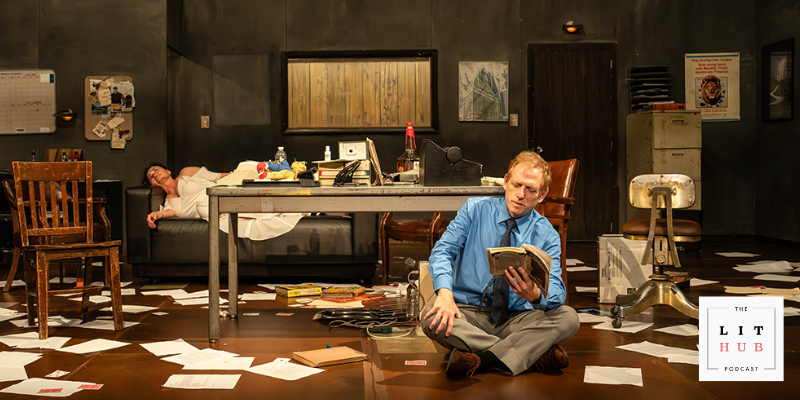 Why is “minor” used so often in its most frustrating sense? “Oh, Sula is just a minor Morrison novel”—I imagine it spoken by a tweedy critic or the worst guy in a graduate-school seminar: people whose incontrovertible aesthetic opinions prioritize scope and magnitude, sheer power, as if they were picking dodgeball teams in gym class. If someone claims that your favorite novel or film or album sucks, that it’s total trash, that’s one thing. Blunt-instrument criticism is easier to dismiss as unsophisticated, or else as evidence of an incommensurable break between this person’s preferences and your own. But “minor” suggests a precision born of long experience, a worldly knowingness. And because of the way aesthetic attachment works, its tendency to mingle your identity with the object in question, this feels like a judgement passed not only on the object or your affinities, but on you. There’s a feeling of being carefully weighed and found wanting. Minor artworks for minor people—this is the implication.
Why is “minor” used so often in its most frustrating sense? “Oh, Sula is just a minor Morrison novel”—I imagine it spoken by a tweedy critic or the worst guy in a graduate-school seminar: people whose incontrovertible aesthetic opinions prioritize scope and magnitude, sheer power, as if they were picking dodgeball teams in gym class. If someone claims that your favorite novel or film or album sucks, that it’s total trash, that’s one thing. Blunt-instrument criticism is easier to dismiss as unsophisticated, or else as evidence of an incommensurable break between this person’s preferences and your own. But “minor” suggests a precision born of long experience, a worldly knowingness. And because of the way aesthetic attachment works, its tendency to mingle your identity with the object in question, this feels like a judgement passed not only on the object or your affinities, but on you. There’s a feeling of being carefully weighed and found wanting. Minor artworks for minor people—this is the implication.
Basically the issue is taste. Calling something minor lays claim to a taste honed and cultivated into sophistication (or its appearance). Critics like Pierre Bourdieu and John Guillory have pointed out that taste is rooted in economic class, that it functions like capitalism’s matador cape, but nevertheless retains a dazzling power. Taste, in theory, combines hard-won expertise and finely tuned sensitivity. A compelling judgement of taste suggests not only that you’ve done the reading, but that you’ve seen something in the reading, something invisible to others. This is why, irritating as they often are, people who project taste also possess an undeniable appeal.
 But there are better ways to think about minor things and the problem of taste. See Helen DeWitt, who writes as deftly as anyone about taste and aesthetic judgement. Herself once something like a minor writer, DeWitt saw her remarkable debut novel The Last Samurai, despite its enthusiastic reception, saved from out-of-print obscurity by a 2016 New Directions reissue after spending 16 years as a mere “cult classic” (a term with a whiff of the minor about it). The Last Samurai is a story of aesthetic education, the development of taste. It centers on a well-read and under-employed woman named Sibylla (she’s a freelance typist, what today we’d probably call a gig worker), who raises her prodigious son Ludo on a system of languages, math, and classical texts. The bulk of the plot follows Ludo’s interrogation of a series of male artists, thinkers, and performers, any one of whom might be his father—but this is at least in part an aesthetic problem. Sibylla worries that Ludo might be unprepared to meet his father, not because Ludo is emotionally immature, but because he’s aesthetically immature. Presenting Ludo with articles clipped from a middlebrow culture magazine, Sibylla claims he “will not be ready to meet [his] father until [he] can see what’s wrong with these things.” In fact, Ludo ought to “despise the people who made these things,” or at least “pity them.” (Here, Sibylla sounds a little like the aforementioned graduate student.)
But there are better ways to think about minor things and the problem of taste. See Helen DeWitt, who writes as deftly as anyone about taste and aesthetic judgement. Herself once something like a minor writer, DeWitt saw her remarkable debut novel The Last Samurai, despite its enthusiastic reception, saved from out-of-print obscurity by a 2016 New Directions reissue after spending 16 years as a mere “cult classic” (a term with a whiff of the minor about it). The Last Samurai is a story of aesthetic education, the development of taste. It centers on a well-read and under-employed woman named Sibylla (she’s a freelance typist, what today we’d probably call a gig worker), who raises her prodigious son Ludo on a system of languages, math, and classical texts. The bulk of the plot follows Ludo’s interrogation of a series of male artists, thinkers, and performers, any one of whom might be his father—but this is at least in part an aesthetic problem. Sibylla worries that Ludo might be unprepared to meet his father, not because Ludo is emotionally immature, but because he’s aesthetically immature. Presenting Ludo with articles clipped from a middlebrow culture magazine, Sibylla claims he “will not be ready to meet [his] father until [he] can see what’s wrong with these things.” In fact, Ludo ought to “despise the people who made these things,” or at least “pity them.” (Here, Sibylla sounds a little like the aforementioned graduate student.)
 Sibylla’s steely opinion might seem at odds with the tenderness she offers Ludo, the hours she spends doing mindless clerical work to maintain their bare economic survival. All the novel’s aesthetic lifers—Sibylla, Ludo, the candidates for fatherhood—share this unsettling quality, a passion darkly edged. There is, The Last Samurai understands, something tantalizing and terrifying about a life led in devotion to aesthetic principles. When strangers see a six-year-old Ludo pretending to read The Odyssey, they’re charmed; when they realize he’s not only reading Homer, but reading Homer in Greek, they recoil. Genius of any kind, but especially when stubbornly achieved rather than divinely bestowed, is always shadowed with the uncanny, even the monstrous.
Sibylla’s steely opinion might seem at odds with the tenderness she offers Ludo, the hours she spends doing mindless clerical work to maintain their bare economic survival. All the novel’s aesthetic lifers—Sibylla, Ludo, the candidates for fatherhood—share this unsettling quality, a passion darkly edged. There is, The Last Samurai understands, something tantalizing and terrifying about a life led in devotion to aesthetic principles. When strangers see a six-year-old Ludo pretending to read The Odyssey, they’re charmed; when they realize he’s not only reading Homer, but reading Homer in Greek, they recoil. Genius of any kind, but especially when stubbornly achieved rather than divinely bestowed, is always shadowed with the uncanny, even the monstrous.
Funnily enough, literary culture has made DeWitt into something like one of her characters. The story of Samurai’s (re)publication and the editorial attempts to make it marketable, along with her polyglottal erudition, have contributed to the image of DeWitt as superlunary genius. As the author’s note on her website states, “Editors of previous bios have liked the 15-odd languages and the varied work history; conversion to Judaism (1985), UK naturalisation (1999) and late onset lesbianism have been seen as TMI.” In other words, it’s easy and reassuring to imagine the author of an unusually brilliant novel about unusual brilliance as herself unusually brilliant, something a little more than human, made safely alien by Olympian gifts. But to imagine her as a product of long, devoted study—well, this makes her too much like us, or worse, who we might have been.
This sense of uncanniness to DeWitt and her work moves us from the pejorative minorness we’ve already mentioned—the marginal, the slight, the overlooked—towards other kinds of minorness, which celebrate the potential of marginality and slightness and obscurity. Writing for the Paris Review, Matthew St. Ville Hunte points out that minor books can encourage underground, diehard attachment because they feel so private, like they “belong to us alone.” Philosophical tag-team Gilles Deleuze and Felix Guattari named Kafka the exemplar of “minor literature,” a kind of sharp-edged whisper or echo inside the dominant language of a particular place and regime. The poet and critic Cathy Park Hong identifies “minor feelings” shared by Asian Americans, a “racialized range of emotions that are negative, dysphoric, and therefore untelegenic, built from the sediments of everyday racial experience and the irritant of having one’s perception of reality constantly questioned or dismissed,” which Hong turns into objects for reflection and criticism.
 In DeWitt’s case another valence of the minor arises: the religious and devotional. “Minor” has roots as a Franciscan designation for a junior monk, an etymological history that fits well with DeWitt’s illustrations of devotion that blur the aesthetic and religious. The stories in her collection Some Trick are full of these illustrations. The author of a children’s book leaves his agent because the agent cannot share his vision of statistical beauty; fans of an obscure Dutch novelist sing his praises to American publishers, finger and fawn over his paraphernalia. If Dewitt’s characters are often devotees, so too are her fans, who attach to her work in that quasi-voluntary way common to aesthetic (and religious) experience, something between choosing and being called. Attempts to describe it either fall into silence or veer into a private language comprehensible only to other people already in the know. Another religiously shaded word useful here is ipseity—unmistakable identity, thisness. Call it, for a writer, style.
In DeWitt’s case another valence of the minor arises: the religious and devotional. “Minor” has roots as a Franciscan designation for a junior monk, an etymological history that fits well with DeWitt’s illustrations of devotion that blur the aesthetic and religious. The stories in her collection Some Trick are full of these illustrations. The author of a children’s book leaves his agent because the agent cannot share his vision of statistical beauty; fans of an obscure Dutch novelist sing his praises to American publishers, finger and fawn over his paraphernalia. If Dewitt’s characters are often devotees, so too are her fans, who attach to her work in that quasi-voluntary way common to aesthetic (and religious) experience, something between choosing and being called. Attempts to describe it either fall into silence or veer into a private language comprehensible only to other people already in the know. Another religiously shaded word useful here is ipseity—unmistakable identity, thisness. Call it, for a writer, style.
DeWitt’s writing has a style: full of mathematical and polyglottal jargon, littered with footnotes, populated by characters with intransigent opinions. And DeWitt’s writing is about style, all those problems of aesthetics and taste. As the narrator of the story “Brutto” suggests, “if you have no sense of style . . . you cannot see.” For all their maladjustment and awkwardness, many of DeWitt’s characters do see, even if the people around them cannot. At least, they see certain things; they possess a vision focused like a microscope lens to detail and texture and tiny, overlooked differences. Other things they miss.
DeWittian style persists in her latest work, which at least in form and stature might seem the likeliest candidate for relegation as “minor DeWitt.” The English Understand Wool is barely 50 pages long, comprised of short chapters and dominated by white space. It appears in the inaugural set of New Directions’s “Storybook ND” collection alongside similarly slim productions from hiply literary writers like Clarice Lispector and László Krasznahorkai. Storybook ND, says New Directions, is meant “to deliver the pleasure one felt as a child reading a marvelous book from cover to cover in an afternoon.” Peter Mendelsund, the closest thing to a celebrity book designer that we have, designed the hardbacks; the cover of The English Understand Wool features a Wayne Thiebaud painting called “Boston Cremes,” a phalanx of delicate, smeary cakes. The books are literary texts, yes, but they’re also objets d’art. (Minor, maybe, in the sense of the ornamental or filigreed.) They remind me of the Little Golden Books that I, having been a markedly less impressive child than Ludo, read when I was very young.
But in turns out that, at least in DeWitt’s case, it all sort of works. Minor DeWitt turns out to be just DeWitt. The story that The English Understand Wool tells is a DeWittian distillate: there’s a precocious child, attention to elegant cultural materials, exasperated and exasperating bureaucratic functionaries. The narrator Marguerite, raised to share her Maman’s calibrated tastes, discovers that her parents are con artists who have absconded with her fortune. But Marguerite isn’t terribly bothered—she considers the fortune a well-spent investment in the acquisition of those tastes. To raise some money, she sells rights to a memoir; her publisher expects a scathing, emotionally expressive tell-all, but as both a narrator and writer Marguerite remains reflective, placid, a little chilly. There’s a twist ending that pivots on the ability of characters to read closely.
The reason Marguerite, like Samurai’s Ludo and so many characters in Some Trick, appears incomprehensible to others is because her priorities are aesthetic, her tastes are uncompromising, and her scale of life is the detail. Marguerite’s publisher assumes she’s hiding a strong emotional response to the whole con-artist-parent thing. It’s taken for granted that such a traumatic event will generate a bunch of feelings, which Marguerite needs to express. The same assumption is often made about novel characters generally, that they ought to be “three-dimensional” or “authentically fleshed out,” which means emotionally expressive, ready to prioritize and discuss their strong and easily nameable feelings, make them the point of thinking and speaking. Of course Marguerite seems inexplicable to this model of character; her priorities seem not just disordered but flagrantly reversed. If typically emotions are major and aesthetics are minor, to elect for the latter over the former must be deviance, a crossed wire, something not quite totally human. It cannot be imagined as an active decision.
But Dewitt’s whole point is that this decision to prioritize the aesthetic is indeed a decision, and a human one. For Marguerite, it is a way of living on. In her case, aesthetic life is full of rich feeling, but these feelings aren’t made public or directed towards people. Her preference runs towards the private, the quiet, the minor—toward what she calls “secret lives.”
The obvious problem with Marguerite’s decision is that attending to secret lives can overlook the actual lives of other people, many of whom make those secret lives possible. It can leave little room for politics, social engagement, a sense of global responsibility. Marguerite displays hardly more concern for her family’s servants or staff—or the fact that her family has servants and staff—than for the oblivious publishing bureaucrats. She wants them treated well not out of ethical or political concern but from a position of noblesse oblige, an avoidance of the “mauvais ton,” the vulgar. Her concern for others is primarily aesthetic. This makes her politically dubious but a fascinating character.
Naturally, DeWitt is aware that aesthetic life can possess real political significance. There is plenty of room in a DeWitt story for political observations as incisive as any aesthetic judgement: “Rich people don’t care about you,” begins a section of the story “Entourage.” The point isn’t that a concern for aesthetics and a concern for politics are irreconcilable, or that minor aesthetics must turn others into minor people. (Marguerite herself, we should note, is effectively an orphan, whose appeal to the publishing company is neither human nor aesthetic but economic—she’s a resource.) The Last Samurai is about an ostensibly minor person, relegated to the economic margins, for whom aesthetic experience is the only way of existing beyond the conditions of bare life. Instead, the point is that aesthetic experience is complex, legitimate, worthy of close attention—and it ought to be available to everyone, but isn’t.
In the context of DeWitt’s work, “minor” can never be applied in general. Minor things are always particular things, which is why DeWitt mostly ignores the minor things that obsess so much contemporary literary fiction, all the bits and motes of the natural world, grasses and sunlight and birdcalls. They all run to sameness. For DeWitt and her characters, differences are key. In their devotion to aesthetic life, her characters make detailed distinctions and fine judgements of taste. Her work, in turn, attends to the differences between those characters, the circumstances of their lives—which is where all good work, aesthetic and political, major and minor, begins.


























































